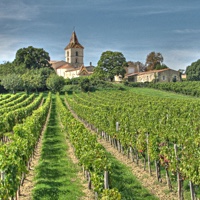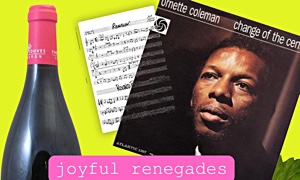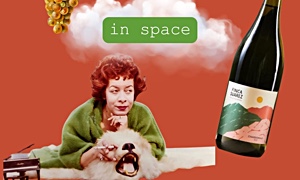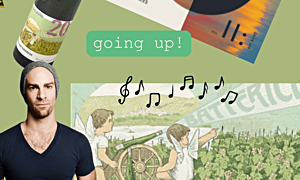Home » Jazz Articles » Jazz & Juice » Structure: Bordeaux Meets Duke Ellington
Structure: Bordeaux Meets Duke Ellington
Which is to say, welcome to Jazz & Juice. The articles, videos and podcasts you'll find here will hopefully bring you to a more informed enjoyment of music and wine, emphasis on the joy.
Structure
For our first exploration together, let's talk about structure. I start with this concept because it's natural to want to learn something bit by bit in order to grasp the whole. Here, we'll be working backwards: instead of building our understanding from the particular to the total, we'll come to know our subjects by being wholly present for an experience. So, as we learn about our featured music and wine, I'd like to think of them as having experiential structures that involve our participation as much as structures unto themselves.The Juice
 I've chosen something classic to get us started, Chateau Mancédre 2016 Pessac Léognan (see comments section for availability.) It's a red Bordeaux from a top appellation, and a vintage being heralded as exceptional. Red Bordeaux has five main grape varieties (cabernet, cabernet franc, merlot, malbec & petit verdot) but in the area on the Western bank of the water (the Garonne river in this case), cabernet sauvignon dominates. The grape itself offers significant structure and integrity (thick skins, intense fruit and color), as do the soils. The gravelly soil of the Pessac Léognan in particular lends the wine many of the characteristics that make it long lived and multi-dimensional—a subject I'm looking forward to exploring with you in next week's video.
I've chosen something classic to get us started, Chateau Mancédre 2016 Pessac Léognan (see comments section for availability.) It's a red Bordeaux from a top appellation, and a vintage being heralded as exceptional. Red Bordeaux has five main grape varieties (cabernet, cabernet franc, merlot, malbec & petit verdot) but in the area on the Western bank of the water (the Garonne river in this case), cabernet sauvignon dominates. The grape itself offers significant structure and integrity (thick skins, intense fruit and color), as do the soils. The gravelly soil of the Pessac Léognan in particular lends the wine many of the characteristics that make it long lived and multi-dimensional—a subject I'm looking forward to exploring with you in next week's video. So let's take in the experience of this wine from first fragrance to finish. Consider these questions as you encounter what's in your glass: What does the wine smell like? Even if you can't name a particular thing, what do the aromas bring to mind for you? Don't worry about specific words for smells. An image, a feeling, a song— it's all great.
On the palate as we sip, what does it feel like? How heavy does it feel in your mouth? What flavors come alive? Does it remind you of anything that you've initially breathed in before?
After swallowing, what's left? A feeling in your mouth? The memory of a smell? A feeling of contentment, excitement, or anticipation?
Let's now open our ears and get to the music.
The Jazz
 If Bordeaux wines are classic, standard bearing, and long-lived, Duke Ellington's work is an excellent corollary in regards to the foundation and vocabulary of jazz. The sheer variety of musical structures that Ellington utilized (and invented) in his career is more than enough to link his work to our main theme—but just this one piece alone gives us more than enough to uncover as we investigate structure.
If Bordeaux wines are classic, standard bearing, and long-lived, Duke Ellington's work is an excellent corollary in regards to the foundation and vocabulary of jazz. The sheer variety of musical structures that Ellington utilized (and invented) in his career is more than enough to link his work to our main theme—but just this one piece alone gives us more than enough to uncover as we investigate structure. I've chosen the thrilling Ad Lib on Nippon, which Ellington wrote with clarinetist Jimmy Hamilton for the album Far East Suite. Its length (around 11 minutes) is an invitation to fully inhabit the structure of musical experience. The challenge (perhaps harder now than ever before with such fierce competition for our attention ) —is to surrender to the journey of the piece while noting our experience of the ride.
It's composed in four movements, all titled to evoke Japan—Fugi, Igoo, Nagoya and Tokyo. Just as we did with the wine, notice how we experience a beginning, middle, and end; both in the entire track, and within each of the four movements. Perhaps pause to ponder the finish—not just the last sounds you hear, but what's there after the musicians stop. Music, like wine, lingers.
There are repeated themes in each part of Ellington's music. When something feels familiar, it's like a fragrance in a glass that brings us a kind of hazy sensual memory. Are there moments of listening that have piquing familiarity for you, when it references something that's come before, or evokes other sounds?
Allowing yourself to truly listen and taste is a singular indulgence. We aren't as interested in identifying and naming this experience just yet. Words, images, feelings may come—that's the nature of reverie.
I'll err on the side of brevity, hoping you'll have time to listen—the track is easy to find online, and there's a version below waiting for you.
What's Next
Every month, Jazz & Juice will have its own structure. This article is our beginning—both an introduction and an invitation. Next week, I'll be with you on a video tasting, where we'll talk about both our subjects in more detail. In the last week of the month we'll meet in a podcast, where I look forward to exploring ideas at greater length, answering your questions, sharing your suggestions, and making way for the next adventure in sound and sense.To that end: I'd love to hear about your tasting and listening, and hear your suggestions and questions. Please leave your comments below, or contact me, with Jazz & Juice in the subject. Let the conversation begin.
Tags
Jazz & Juice
duke ellington
Kristen Lee Sergeant
Jimmy Hamilton
Chateau Mancedre 2016 Pessac Leognan
Ad Lib on Nippon
jazz and juice
PREVIOUS / NEXT
Support All About Jazz
 All About Jazz has been a pillar of jazz since 1995, championing it as an art form and, more importantly, supporting the musicians who make it. Our enduring commitment has made "AAJ" one of the most culturally important websites of its kind, read by hundreds of thousands of fans, musicians and industry figures every month.
All About Jazz has been a pillar of jazz since 1995, championing it as an art form and, more importantly, supporting the musicians who make it. Our enduring commitment has made "AAJ" one of the most culturally important websites of its kind, read by hundreds of thousands of fans, musicians and industry figures every month.
























